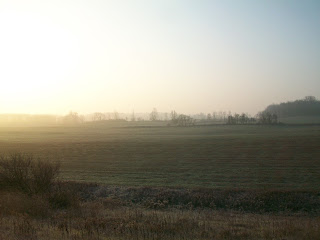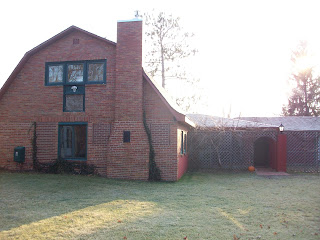In the twentieth century, Russell Kirk laid the intellectual foundations of an contemporary academic defense of traditional conservatism, before passing into glory in 1994 (watch the excellent clip above from Kirk on the Hebraic and Christian foundations of Western civilization and the purpose of the academy). His generational home, Piety Hill remains a haven for those who are being buffeted by Post-modernism in the academy. It is the Imladris of learning and the Last Homely House with professorial manners to many of us Christian conservatives in the academies of America. Needless to say, I visit often, but yesterday I came for Thesis research. Mrs. Kirk invited me to a wonderful lunch and enlightening discussion with the Wilbur Fellows. Quietness seems to pervade the place, a peaceful timelessness. Here are some pictures of my visit, with some accompanying captions. Happy Thanksgiving!
Redeemed in Jesus,
Wesley
The rolling "Bundee Hills," as Professor Kirk referred to them (sorry, the real rises are hidden in the sun's glare and morning mist).
On the roadside, an old rickety Victorian farmhouse, in stark contrast to...
Piety Hill, entrance, Victorian Romanesque Revival
The Library, Victorian farmhouse style
Library trellis entrance
Library courtyard
Library front door (with lamp in the reflection)
Just inside the library
To the left
The Professor's friend and distinguished poet, T. S. Eliot
The Professor's manual typewriter.
The old family clock
The library hearth
Hearth stone murals (the professor was a Roman Catholic)
The library lecture hall, with Royal Stuart tartan carpet pattern
Bust of the Professor among his books The Sword of Imagination and The Conservative Mind
Long-shot of the library lecture hall
Back at the home for lunch after a morning's read
For those of you who doubted my involvement in all of this
The dinning room
Originals of some of Sir Walter Scott's letters
Architecture in the dinning room
Scottish Romantic wall-hangings
Back at the library, my work setup
Some good books (see my previous post for summary)
The library hearth with the gas fireplace "on" (it used to burn wood, in the Professor's days)
The Professor's workplace
The Professor reviving the Presidential Citizens Medal from Ronald Reagan in 1989
Notice the book on John Knox to the left
An inquisitive gnome on the shelf, like me.
A bust of Robert E. Lee, I think?
A bust of Abraham Lincoln





















































Quite a place! (Yes, that is Robert E. Lee.)
ReplyDelete-Peter B.
DV
Thanks Peter. That's what I kind of thought, but I just couldn't remember only three stars on his coat. Do you remember the significance of that?
ReplyDeleteGood observation, I didn't notice that. Robert E. Lee, as well as several other Southern generals such as Joseph E. Johnston, sometimes wore the insignia of a colonel (three stars). The book I'm looking at now says that they did it for no apparent reason. Probably because Confederate uniforms were less standardized than the Northern uniforms.
Delete-Peter B.
DV
Wow, thank you for the cultural history there, Peter. I never knew that.
ReplyDelete